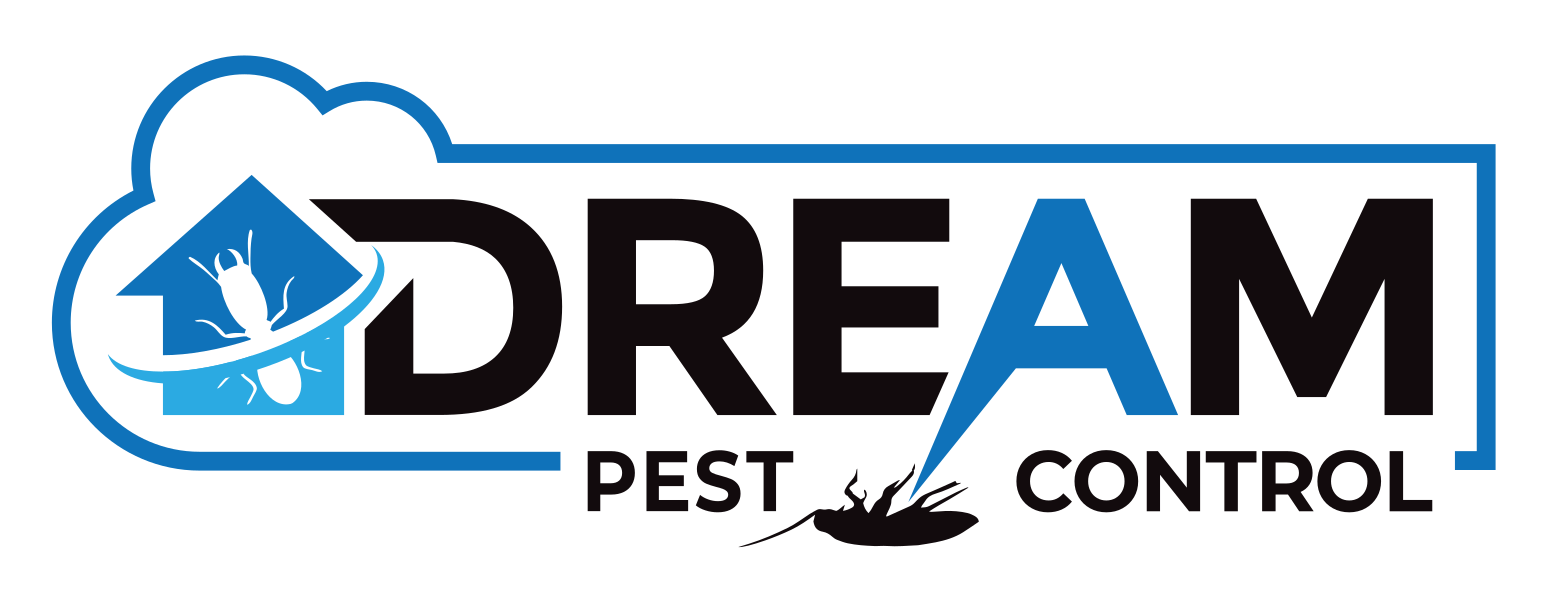Don’t let an ant infestation spoil your living or work space.
As one of the most persistent pests, ants can infiltrate your property in large numbers, causing distress and discomfort. At Dream Pest Control, we specialise in providing effective ant control services that safeguard your premises from these resilient insects. With our assistance, you can enjoy an ant-free environment, protecting your property from damage and maintaining a high standard of hygiene.
Contact Dream Pest Control today to schedule a comprehensive ant control service. Together, we can help you reclaim your property and protect it from the nuisance caused by these tiny invaders.


Why Do I Need Ant Control?
Ants may seem small and harmless, but an infestation in your property can lead to significant problems. They are not just a nuisance but can pose genuine threats to your health and safety. Ants can contaminate food and spread bacteria, leading to potential health risks for you and your family. Some species, such as the carpenter ants, are notorious for causing structural damage as they hollow out wood for nesting. Additionally, ants are social insects with a large colony size, meaning a small problem can rapidly escalate into a significant infestation.
Our Approach to Ant Management
At Dream Pest Control, we’re dedicated to providing our clients with a safe, efficient and environmentally-conscious solution to their ant issues. Our team of trained professionals use a variety of techniques specifically tailored to manage ant infestations. When you choose to work with us, here’s what you can expect:
- In-depth Property Assessment: Our technicians will thoroughly assess your premises, identifying the severity of the infestation, locating ant nests, and determining the ant species involved.
- Individualised Treatment Strategies: Each ant issue is unique. Hence, we develop bespoke treatment plans that consider the distinct aspects of your infestation, including the ant species and infestation intensity.
- Targeted Ant Treatment: Our treatments are designed to specifically target the ant species causing the problem. We apply carefully selected solutions to ant trails and entry points, which ants carry back to their colony, helping to reduce their numbers significantly.
- Post-Treatment Evaluation: If deemed necessary, we revisit your property to assess the effectiveness of our ant management plan, and provide guidance to avoid future invasions.
- Commitment to Quality Service: Rest easy knowing that our procedures align with the most stringent industry standards, helping to keep your home or business premises free from ants.


How to Prevent Ants?
Preventing an ant infestation is a proactive step in maintaining a pest-free environment. The primary strategy involves eliminating the elements that attract ants – food, water, and shelter. Here are some practical tips:
- Maintain cleanliness: Regularly clean your kitchen and dining areas. Wipe down surfaces, sweep up crumbs, and don’t leave dirty dishes out.
- Seal Food Containers: Ants are attracted to food, especially sweet and sticky substances. Keep food in tightly sealed containers and promptly clean up any spills.
- Store food properly: Keep food stored in airtight containers and promptly clean up spills and crumbs to avoid attracting cockroaches.
- Address Moisture Issues: Many ants are attracted to moisture. Address leaky pipes and ensure your property has adequate drainage to avoid standing water.
- Seal Entry Points: Ants can enter your home through the tiniest of gaps. Seal windows, doors, and any cracks in your home’s exterior to prevent entry.
- Regular Inspection: Keep a watchful eye for signs of ant activity, such as ant trails, particularly in kitchen and bathroom areas. Early detection can prevent a full-blown infestation.
Common Ant Species in South-East Queensland
Australia is home to over 1,300 known species of ants, an amazing showcase of biodiversity considering this figure represents about 15% of the world’s ant species. However, in South-East Queensland, homeowners are more likely to encounter only a select few of these species inside or around their homes. These tiny but mighty insects can perform superhuman feats, such as carrying up to 50 times their own body weight! Beyond their strength, what’s truly remarkable is how ant colonies operate. These complex societies function as a single unit, often described as a ‘superorganism’, thanks to a highly organised social structure and a sophisticated division of labour. Communication is key in these communities. Ants use an intricate system of chemical signals, or pheromones, to send specific messages to their fellow ants, effectively coordinating collective efforts for tasks such as foraging and defense. Now let’s take a look at some of the most common ant species you might find in and around your home on the Gold Coast.

Black House Ant (Ochetellus Glaber)
Also known as: Dark Brown House Ant
Appearance: These ants are a shiny dark brown to black in colour, and their body length measures between 2.5 and 3 mm.
Habits: Omnivorous in nature, Black House Ants have a preference for sweet food, but they will also feed on insects and other small creatures. They are often found nesting in soil, timber, among rocks, as well as in wall cavities or roof spaces in buildings.
Colony: Colonies of the Black House Ant are generally small to moderate in size, housing hundreds to thousands of workers.
Risks: While they pose little physical threat to humans, their fondness for nesting in homes can lead to them contaminating food sources and causing an annoyance due to their persistent presence.
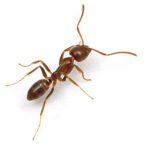
Argentine Ant (Linepithema Humile)
Appearance: Argentine Ants are light to dark brown in colour, with body lengths measuring between 2 and 3 mm.
Habits: They consume a wide range of foods, showing a particular preference for sweet substances. These ants often establish their nests in moist soil, alongside sidewalks, or underneath buildings.
Colony: Argentine Ant colonies can be significantly larger than those of the Black House Ant, often containing thousands of workers and multiple queens.
Risks: Despite posing little direct threat to humans, their large colonies and aggressive nature can result in significant property damage. Furthermore, they have been known to outcompete and negatively impact native fauna.

Coastal Brown Ant (Pheidole megacephala)
Also known as: Big-headed Ant
Appearance: Workers of this species are dimorphic, meaning they come in two distinct sizes: minor workers measuring about 1.5-2.5mm and major workers measuring up to 3.5mm. They are light brown to yellowish in colour.
Habits: Coastal Brown Ants are attracted to fatty foods and protein sources, but will also feed on sweet substances. They typically nest in soil, pavement cracks, beneath objects on the ground, or within structures.
Colony: Colonies of Coastal Brown Ants are usually large, often containing several queens and numerous workers.
Risks: These ants can cause considerable damage to lawns and gardens due to their habit of excavating soil and displacing turf.

Fire Ant (Solenopsis Invicta)
Appearance: Fire ants are typically small to medium-sized, with workers ranging from 2-6mm in length. They have a copper brown head and body with a darker abdomen.
Habits: Known for their extremely aggressive behaviour, fire ants readily attack anything that disturbs them or their mound, stinging the intruder repeatedly. They are omnivorous, but prefer high-protein foods.
Colony: A typical fire ant colony produces large mounds in open areas and can host up to 200,000 individuals. It’s important to note that their nests have no visible entrances as ants enter and exit through underground tunnels.
Risks: Fire ants are considered a significant biosecurity risk because of their ability to disturb and damage the local ecosystem, agriculture, and wildlife. Their painful, burning sting can cause severe reactions, especially to those allergic to their venom. Their presence in populated areas poses threats to people, pets, and even small livestock.
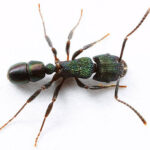
Green-head Ant (Rhytidoponera Metallica)
Also known as: Metallic Pony Ant
Appearance: Green-head ants are small, usually measuring between 5-7mm in length. Their entire body exhibits a distinctive metallic sheen that can range from green to purple or bluish, hence their common name.
Habits: Green-head ants are omnivorous, feeding on a variety of food sources such as small insects, honeydew, nectar, and household scraps. They forage both day and night and usually travel in trails. In the wild, they prefer open, sunny areas and can often be found in lawns and gardens. In urban settings, they may be found under paths, pavers, and rocks, or in sandy soils. When disturbed, they may bite, resulting in a painful sting.
Colony: Unlike many other ant species, Green-head ants form relatively small colonies, typically ranging from a few hundred to a few thousand individuals. Each colony usually has multiple queens. The ants are solitary foragers and don’t typically form long foraging trails.
Risks: Green-head ants pose a risk due to their painful sting, which can cause allergic reactions in some individuals.
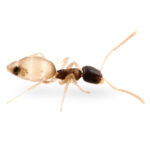
Ghost Ant (Tapinoma Melanocephalum)
Appearance: Ghost Ants have a dark head and thorax with a pale, almost translucent, abdomen and legs, which gives them their ‘ghost-like’ appearance. Workers are tiny, about 1.3-1.5mm long.
Habits: Ghost Ants have a preference for sweet foods and are often found trailing in kitchens and bathrooms where they seek moisture.
Colony: Colonies are usually moderate to large in size with multiple queens.
Risks: Though they pose no physical danger, Ghost Ants can be a nuisance due to their fondness for indoor habitats.

Funnel Ant (Aphaenogaster Longiceps)
Appearance: Funnel Ants are a light brown colour and measure about 6-8mm in length.
Habits: These ants are known for creating distinctive funnel-shaped entrances to their nests in the ground, which can cause unsightly mounds in lawns.
Colony: Funnel Ant colonies are quite extensive with large networks of tunnels and chambers.
Risks: Funnel Ants pose a significant risk to the aesthetic appeal of your lawn and can cause extensive damage.

Carpenter Ant (Camponotus spp.)
Appearance: Carpenter Ants are large ants, ranging from 6-12mm in length, and are typically black, although some species may have reddish or yellowish colouration.
Habits: They don’t eat wood, but will hollow it out to build their nests, preferring moist, decaying wood.
Colony: Carpenter Ant colonies are moderate in size, often containing up to 10,000 workers when mature.
Risks: They pose a risk to property as their nest building can cause damage to wooden structures.

Pharaoh Ant (Monomorium Pharaonis)
Appearance: Pharaoh ants are small, about 2mm long, and are yellow or light brown in colour.
Habits: These ants are drawn to sweet, fatty, and protein-based foods. They often nest in warm, humid areas, especially in kitchens and bathrooms.
Colony: Pharaoh ant colonies can be extremely large with multiple queens, sometimes numbering in the hundreds of thousands.
Risks: Pharaoh ants can pose a health risk as they are known to spread diseases such as salmonella and staphylococcus.
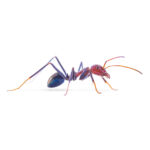
Meat Ant (Iridomyrmex Purpureus)
Appearance: Meat ants are medium-sized, ranging between 6-10mm in length, and have a blue-green metallic sheen on their black or dark brown bodies.
Habits: They are primarily scavengers and get their name from their preference for high-protein foods.
Colony: Meat ant colonies can be extensive, often consisting of several nests connected by well-travelled paths, and may house up to 100,000 ants.
Risks: While they are generally not aggressive towards humans, their large numbers can be a nuisance.

Sugar Ant (Camponotus Consobrinus)
Appearance: Sugar ants are large, measuring between 5-15mm in length, with a light brown to black colour.
Habits: Sugar ants are attracted to sweet substances and are often found foraging in and around homes.
Colony: Their colonies are large, with several thousand workers and numerous queens.
Risks: Sugar ants don’t pose any significant health risk, but they can be a nuisance when they invade homes in search of food.

Whitefooted House Ant (Technomyrmex spp.)
Appearance: They are small ants, measuring about 2.5mm in length, and notable for their dark bodies and lighter-coloured feet.
Habits: These ants are attracted to sweet substances and are typically found in moist, shaded areas.
Colony: Whitefooted house ant colonies contain multiple queens and can grow quite large.
Risks: While they do not pose a significant health risk, their colonies can grow to large numbers, making them a nuisance in and around homes.
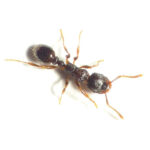
Pavement Ant (Tetramorium Caespitum)
Appearance: Pavement ants are small, measuring 2.5-4mm in length, with dark brown to black bodies.
Habits: Pavement ants earn their name from their tendency to nest under pavements, building small mounds of sand or soil. They are attracted to a wide variety of foods, especially greasy and sweet substances.
Colony: Pavement ant colonies can contain up to 10,000 members with multiple queens.
Risks: These ants pose no significant health risk but can become a significant nuisance when they enter homes in search of food.
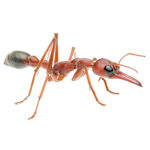
Bull Ant (Myrmecia spp.)
Appearance: Bull ants are large and intimidating, ranging from 15-40mm in length, with a red or black body and large, powerful jaws.
Habits: Bull ants are primarily found outdoors, often nesting in soil or under rocks.
Colony: Bull ant colonies are relatively small, typically housing around 600-2000 ants.
Risks: Bull ants are known for their painful bite and can pose a significant risk to people who are allergic to their venom.
Appreciating the diverse ant species that often take residence in South-East Queensland homes is a significant step towards effective ant control. If you observe any signs of ant activity, Dream Pest Control is just a call away. We provide expert services to successfully eliminate these nuisance insects from your premises, ensuring your home remains comfortable and ant-free.
